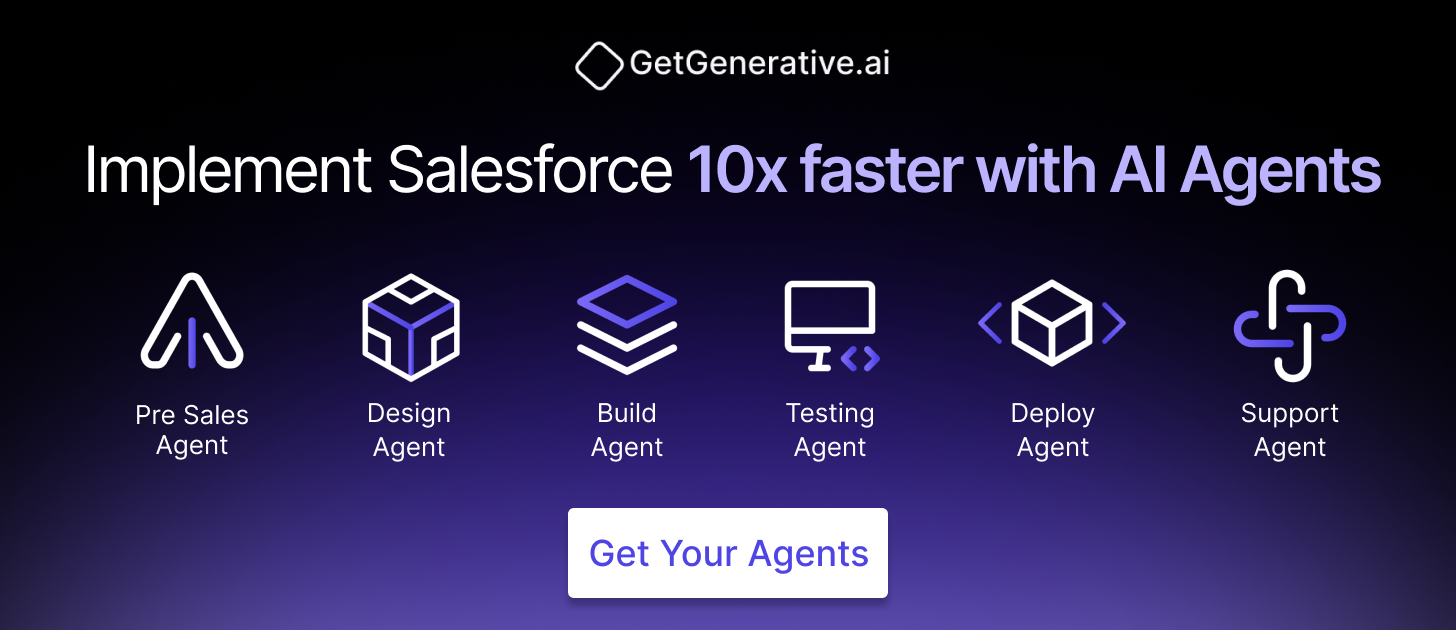Vibe Coding in Salesforce: What It Is and Why It’s the Future
What if you could describe a Salesforce feature in natural language and instantly receive production-ready code? This is no longer futuristic speculation; it’s the reality of vibe coding.
Coined by Andrej Karpathy, vibe coding means coding by intent: using AI systems to generate the first draft of code from natural-language instructions. Developers act as orchestrators, refining and validating what AI produces — saving time and elevating their strategic role.
Salesforce’s own metrics reflect this shift: over a recent 30-day period, 20% of new Apex code was AI-generated, involving 35,000 developers who saved an estimated 30,000 hours. As forecasts predict that up to 90% of code may soon be written by AI, it’s clear that vibe coding isn’t just a trend — it’s a foundational shift in how software gets built.
This blog explores the meaning of vibe coding, its transformative power in the Salesforce ecosystem, and provides real-world examples. Let’s get started!
What Is Vibe Coding in Salesforce?
Vibe coding is an AI-driven development approach where natural language becomes the new syntax. Rather than writing lines of code, a developer inputs prompts like:
“Create an Apex trigger to notify the Sales Manager when an Opportunity is marked Closed-Won.”
AI agents — trained on large Salesforce datasets — then generate functional, well-structured code. Developers guide, test, and refine the results, acting like senior architects directing a rapid, tireless junior developer.
This is not just about replacing manual coding — it’s a shift toward intent-first development, where business requirements directly map to code through AI interpretation. Whether you’re building Apex classes, Lightning Web Components, validation rules, or flows, vibe coding removes friction between ideas and execution.
Importance of Vibe Coding in Salesforce
Salesforce development has traditionally required knowledge of Apex, SOQL, JavaScript, and metadata configuration. Vibe coding democratizes access by enabling even junior developers or business analysts to create real solutions through clear, English-based code. More than just low-code, it’s a form of no-barrier, AI-driven coding that bridges gaps and accelerates project delivery.
Why Vibe Coding Is the Future of Salesforce Development
1. Unmatched Speed and Productivity
AI-generated code drastically cuts development time. Salesforce reported that weeks-long feature builds can now be prototyped in a single afternoon. One developer at a major firm used AI tools to deliver a React + Salesforce backend integration in one day, enabling faster feedback loops and rapid iteration.
- GitHub data confirms up to 55% faster coding with AI pair programmers.
- Salesforce internal stats show millions of AI-written lines monthly, saving tens of thousands of hours.
For consultancies and agile teams, this is game-changing, reducing time-to-market while boosting innovation bandwidth.
2. Higher-Value Contributions from Developers
With AI handling boilerplate code and scaffolding, developers shift their focus to strategic architecture, business alignment, and system design. One Salesforce architect noted a move “from syntax to solutioning,” working directly with stakeholders on translating vision into action.
This transformation elevates developers from implementers to technology partners, enabling more cross-functional collaboration and deeper business impact.
3. Bridging Skill Gaps and Empowering Teams
Generative AI helps junior developers punch above their weight and allows lean teams to take on complex projects.
- A business analyst can describe a feature in plain English.
- The AI generates corresponding code or configuration.
- A developer validates and deploys it.
A recent survey revealed 59–88% of enterprises now actively encourage AI pair programming, recognizing its role in scaling teams without always scaling headcount.
4. Quality, Consistency, and Scale
AI code generation isn’t just faster — it’s often cleaner and more consistent. AI-generated code tends to follow best practices, consistent formatting, and secure defaults.
- GitHub found AI-authored pull requests were 5% more likely to be approved than human ones.
- Salesforce uses its Agentforce Testing Center to generate automated test cases alongside AI-written Apex, improving coverage and robustness.
This allows teams to build at scale, launching more features faster, while AI ensures quality and standards compliance.
Real-World Examples and Use Cases
Salesforce’s Internal Adoption
Salesforce reports that one in five lines of Apex code in recent production builds was authored by AI agents. Over 35,000 developers internally use these tools, contributing to over 10 million lines of AI-generated code monthly. Engineers now act as “technology pilots,” steering AI toward business outcomes and rapid prototyping.
Rapid Prototyping for Startups
A founder building a school finance platform used Vibe coding to create a functional React frontend and Apex backend in one day. What once took a week was reduced to hours, allowing faster user testing and iteration, all guided by natural-language prompts and AI-driven scaffolding.
Also Read – How to Generate Apex Code with AI
Adopting Vibe Coding: Challenges and Best Practices
While vibe coding offers immense promise, successful adoption requires more than installing a tool — it demands cultural, procedural, and technical alignment. Below are the key challenges and how to address them:
1. Keep Developers in the Loop
AI-generated code is probabilistic — it may sound confident, but can still be incorrect, insecure, or suboptimal. Salesforce’s internal teams found even high-accuracy models needed additional QA and human judgment.
Best Practices:
- Treat AI as an assistant, not an autonomous coder.
- Maintain rigorous code reviews and automated testing.
- Add checklists for security, scalability, and compliance to review AI-authored code.
AI should be your first draft assistant, not your final decision-maker.
2. Upskill Teams in Prompt Engineering
The new literacy for developers is writing effective prompts — the better the input, the better the code output.
Recommendations:
- Train teams in prompt engineering (e.g., specificity, examples, context).
- Encourage workshops or mini-hackathons using AI coding agents.
- Use “Vibe Coding 101” style onboarding — some L&D teams even build internal prompt libraries for reuse.
Crucially, strong fundamentals in computer science and architecture still matter — AI amplifies good thinking, not bad habits.
3. Pilot with Purpose-Built Tools
There’s a growing ecosystem of AI tools — not all are enterprise- or Salesforce-ready.
Salesforce-Specific Tools to Consider:
- GetGenerative.ai’s Code Agent – generates Apex, config, metadata from prompts.
- Einstein GPT + CodeGenie – Salesforce-native AI assistant for developers.
- GitHub Copilot – IDE-based assistant (VS Code, IntelliJ) for generic use.
Pro Tip: Start in a Salesforce sandbox. Run a small end-to-end user story. Document metrics: delivery time, code quality, developer feedback, and integration ease.
4. Update Governance and DevOps Processes
AI introduces new governance questions:
- Who owns AI-written code?
- How is it tracked?
- Is private org data being sent to third-party models?
Recommended Actions:
- Add metadata to track AI-generated commits.
- Define policies for prompt creation, code validation, and AI use boundaries.
- Use enterprise tools that offer on-prem or secure deployment options for AI models.
For regulated industries, early involvement of compliance and security teams is essential. Some tools now support metadata diffing, inline code audits, and secure deployment pipelines — ensure your solution does too.
5. Build an AI-Positive Team Culture
Some developers may feel threatened or skeptical, while others may overtrust the AI. Your culture will determine how effectively vibe coding is adopted.
Tips to Build a Collaborative Mindset:
- Celebrate success stories internally — e.g., a developer using AI to crush a backlog.
- Share prompt templates and “what worked” across teams.
- Emphasize AI is a creative accelerator, not a replacement.
Pair programming models can evolve too: consider human + AI pairs, or even small triads including one developer as “prompt lead,” another as “reviewer,” and an AI in the loop.
Also Read – Reinventing Salesforce Implementation with the AI Native Delivery Framework
Strategic Takeaways for Salesforce Stakeholders
Whether you’re leading a Salesforce practice, managing delivery teams, or overseeing digital transformation, vibe coding can drive real business outcomes. But only if you act intentionally.
Strategic Area | Recommendation |
Tooling | Choose Salesforce-aware tools like GetGenerative.ai Code Agent or CodeGenie |
Training | Upskill developers in prompt engineering and AI code review |
Security & Governance | Involve IT, security, and legal early to define policies for AI code usage |
DevOps Integration | Ensure AI tools integrate with Git, sandboxes, and deployment pipelines |
Culture | Foster a mindset of AI + human = better through education and experimentation |
The goal isn’t to automate developers away — it’s to make them 50% faster and 10X more impactful.
Conclusion
Vibe coding isn’t a side experiment anymore — it’s a fundamental shift in how Salesforce solutions are imagined, developed, and delivered. As AI capabilities mature and platforms like GetGenerative.ai and Salesforce’s Agentforce ecosystem expand, we’ll see:
- Less time spent coding manually, more time spent shaping experiences
- More participation from analysts, architects, and citizen developers
- Faster iterations and feedback loops, powering a truly agile Salesforce ecosystem
At GetGenerative.ai, we’ve built an AI-powered workspace that lets you manage the entire Salesforce implementation lifecycle — from proposals to production — with natural language and intelligent agents.
✅ Turn ideas into scope documents
✅ Generate Apex code and metadata instantly
✅ Deploy with built-in testing and audit trails
👉 Book a free demo and experience how our Code Agent makes vibe coding a reality in your Salesforce projects.




